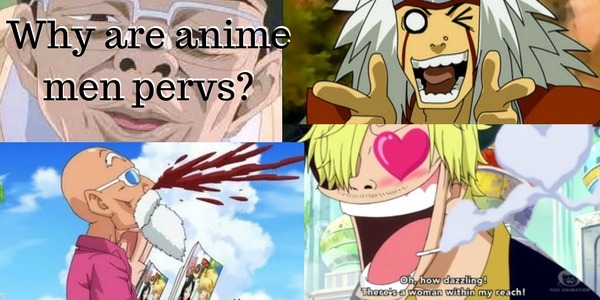 Fans of anime often ask me why anime has so many perverted men. On the surface, we can say its because of the fans or because of Japan’s sexual culture, but as usual, the true answer involves more complexity. Perverted comedy is a niche despite its proliferation online. The Internet has a tendency to take a niche and make it appear more popular than it is. Most anime I’ve seen have few perverted male characters, and when they do appear, they appear as comedy relief. So part of the reason is a perception problem. A section of the anime community focuses on these characters and stories because of their immaturity. Hormonal teens run amok online on forums and social media, but they don’t represent the majority of anime fans. From my own anecdotal experience, most anime fans in the United States are teenage girls and young women. Women dominate the anime blogging community.
Fans of anime often ask me why anime has so many perverted men. On the surface, we can say its because of the fans or because of Japan’s sexual culture, but as usual, the true answer involves more complexity. Perverted comedy is a niche despite its proliferation online. The Internet has a tendency to take a niche and make it appear more popular than it is. Most anime I’ve seen have few perverted male characters, and when they do appear, they appear as comedy relief. So part of the reason is a perception problem. A section of the anime community focuses on these characters and stories because of their immaturity. Hormonal teens run amok online on forums and social media, but they don’t represent the majority of anime fans. From my own anecdotal experience, most anime fans in the United States are teenage girls and young women. Women dominate the anime blogging community.
Japanese Sex Culture and Perverted Anime Men
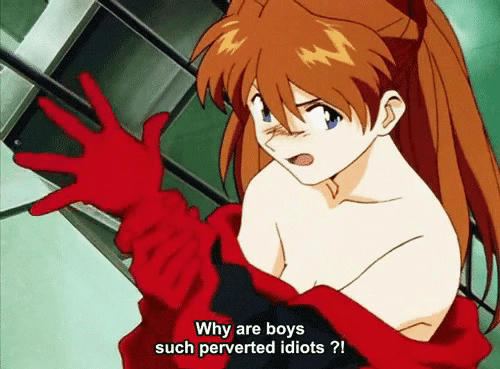 People like to pin perverted male characters on the sexual repression in Japanese culture. Yet, for those of us who study the culture, we know it isn’t truly repressed, at least not in the same way as American culture. Japanese sexual culture features an emphasis on fantasy. Perverted male characters play into this fantasy by providing an outlet for actions that are taboo in the public eye. It comes back to the idea of social harmony. People don’t have the freedom to act out in ways that disrupt the harmony of society, as perverted characters do. Of course, this doesn’t stop men from groping women on subway trains or from taking clandestine panty photos. Such behavior is not acceptable. Fictional perverted men, however, provide an acceptable, humorous outlet for men who want to buck social demands. It works the same way as action heroes here in the US. Action heroes act in ways everyday men cannot, shooting or beating people who oppose them, driving fast, and saving the girl. They provide an outlet for masculine fantasies.
People like to pin perverted male characters on the sexual repression in Japanese culture. Yet, for those of us who study the culture, we know it isn’t truly repressed, at least not in the same way as American culture. Japanese sexual culture features an emphasis on fantasy. Perverted male characters play into this fantasy by providing an outlet for actions that are taboo in the public eye. It comes back to the idea of social harmony. People don’t have the freedom to act out in ways that disrupt the harmony of society, as perverted characters do. Of course, this doesn’t stop men from groping women on subway trains or from taking clandestine panty photos. Such behavior is not acceptable. Fictional perverted men, however, provide an acceptable, humorous outlet for men who want to buck social demands. It works the same way as action heroes here in the US. Action heroes act in ways everyday men cannot, shooting or beating people who oppose them, driving fast, and saving the girl. They provide an outlet for masculine fantasies.
Japanese culture faces a decrease in birth rates in recent years as people’s interest in sexuality declines and polarizes (Ishikawa, 2015):
The number of adolescents stating that they were sexually active in 2011 was lower than in 2005 or 1999, and the same as in 1993. Moreover there appears to be a polarization among adolescents; while some become sexually active at an early age, there are others who do not seem interested in sex.
This environment impacts anime as a commercial product. In Ishikawa’s study (2015), 5% of males with stay-at-home mothers reported to have had sex under the age of 18 while those with working mothers rated at 9.1%. In either case, the rates of sexual activity among teenage males rates low. The majority don’t have sex according to Ishikawa. This is why the awkward virgin character appears more than the perverted, sexually-active male. More people can identify with him than the perverted side character who brags about his conquests. But, at the same time, the perverted character remains because it represents a persona some men wish they could be or experience. Harem anime center on male escapist fantasies.
Marriage doesn’t provide a sexual outlet, however. According to the Association of Japanese Family Plan, in 2014 married couples reported that they do not have sex more than once a month. The parent-child relationship rates as more important than the husband-wife relationship ( Ishikawa 2015). This offers a reason why perverted male characters stereotype as older men–think Master Roshi and Jiraiya–more often than teens. It provides a outlet for men who may feel dissatisfied with the focus on children within their marriages. These characters also allow them to laugh at their own sexual state by providing an absurd opposite.
I have to note that anime often features innocence as a type of perversity. For example, in Dragonball, Goku often looks up skirts. This may appear lewd to Americans, but it can be seen as a child’s curiosity instead of an expression of sexuality. Some teen characters feature this same level of curiosity and innocence. This differs from true perversity which has a lustful component and a drive for sexual gratification. Perversity has an element of curiosity. Even men who are sexually experienced retain this curiosity.
Teenage Male Groups and Attitudes Toward Sex
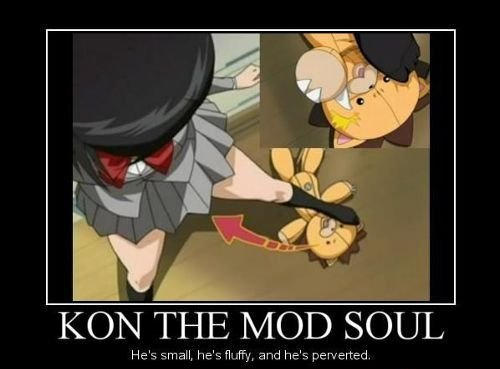 In the US, anime most often associates with teens so let’s return to that age group for a moment. Castro-Vanquez performed a case study of a Japanese senior high school back in 2003. While the study had a small sample size and can’t be extrapolated to the general population, it revealed a few useful ideas. In the study, students fell into one of four categories:
In the US, anime most often associates with teens so let’s return to that age group for a moment. Castro-Vanquez performed a case study of a Japanese senior high school back in 2003. While the study had a small sample size and can’t be extrapolated to the general population, it revealed a few useful ideas. In the study, students fell into one of four categories:
- Grinders – those who believed in hard work and restrained sexual activity. They believed hard work was the key to success and they spent their time studying instead of socializing.
- Lifestylers – those who searched for their own path and had a critical view of school. These boys disliked Grinders and Sporting Boys and began to have sexual relationships.
- Sporting Boys – these students believed in hard work and discipline. They drew sharp distinctions between masculinity and femininity, believing girls were feeble, vulnerable, and in need of protection.
- Confident Heterosexuals – these boys focused on their sexual and social performance with girls. They viewed the loss of virginity as essential for adulthood.
Grinders and Confident Heterosexuals stand at odds with each other. Grinders viewed sexuality as opposite academic achievement and success:
Q: Are you saying that having sex and academic achievement contradict one another?
A: … For example my friends, whom I attended kindergarten with, they have many girls, they are always causing problems and they are having a lot of sex. It sounds a little bit biased, but their academic abilities, and abilities in general are different. The schools, the schools they attend are not that good. They don’t restrain themselves. They do mainly sports. They play around. They have sex when they feel like … The environment where they live is just different.
(Masashi, 18 years old)
Whereas the Confident Heterosexuals considered sex as a product of manliness. Inside these 4 categories, we also see anime character stereotypes. Lifestylers and Confident Heterosexuals contain the perverted anime male character. Most perverted characters embrace their sexual drive, and some equate it with manhood. This contrasts with innocent interest in gender differences some characters convey.
Lifestyler male characters may have an extreme interest in sex, but they also have enough fear that they never follow through with the act, such as Aito in The Comic Artist and His Assistants. The conflict appeals across the different categories and provides for humorous situations. They want to look but not touch while the Confident Heterosexual brag about what they’ve done. Because of their confidence and follow through, Confidents don’t provide the same tension in a story as Lifestylers. Female Grinders often appear as closet perverts in anime.
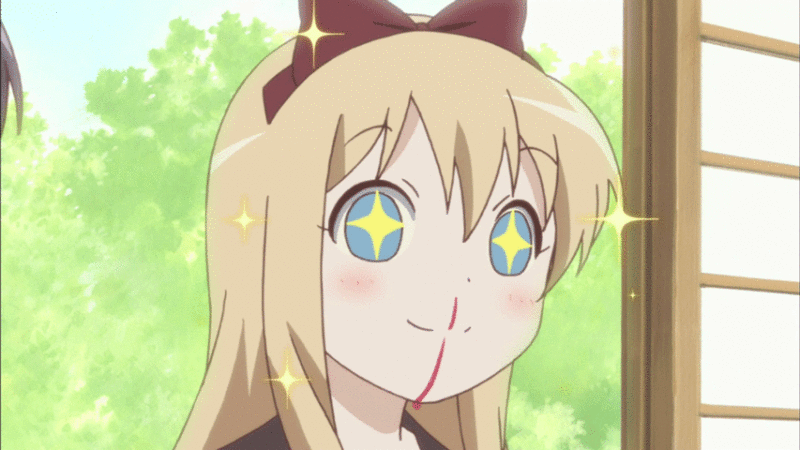 Speaking of female characters, for most of Japanese history, women were considered more sexual than men. The West also held this same view; however, unlike male sexuality, female sexual desire was used as a reason for repression in the West. The story of Eve and the fall of humanity from paradise cast a long shadow on female sexuality. During the European Middle Ages, female sexuality sometimes equated with demonic behavior. As for Japanese history, female sexuality simply wasn’t mentioned. Some ukiyo-e prints and sex manuals from the Tokugawa period depict women enjoying sex, but on the whole it wasn’t discussed. This silence has carried through to anime, although in shojo stories and yuri stories you’ll see more overt female sexuality. This trend is slowly changing. Female characters that own their sexuality are appearing in more anime, such as Kill la Kill.
Speaking of female characters, for most of Japanese history, women were considered more sexual than men. The West also held this same view; however, unlike male sexuality, female sexual desire was used as a reason for repression in the West. The story of Eve and the fall of humanity from paradise cast a long shadow on female sexuality. During the European Middle Ages, female sexuality sometimes equated with demonic behavior. As for Japanese history, female sexuality simply wasn’t mentioned. Some ukiyo-e prints and sex manuals from the Tokugawa period depict women enjoying sex, but on the whole it wasn’t discussed. This silence has carried through to anime, although in shojo stories and yuri stories you’ll see more overt female sexuality. This trend is slowly changing. Female characters that own their sexuality are appearing in more anime, such as Kill la Kill.
Commentary on the Pervert
The Pervert strikes me as more annoying than funny, but then anime’s comedic characters often annoy me. Humor doesn’t translate across cultures sometimes. The main issue with the perverted male centers on how it spreads across the internet and makes some think such behavior is okay. I’ve ran into male anime fans that think its funny to look up women’s dresses and other anime comedic behavior. They miss the main point of those characters: such behavior isn’t okay. They appear in anime to provide an outlet and to show how such behavior is disruptive and tone deaf. It put it simply, they show how it is not okay to be a pervert. In most anime stories, the male pervert fails to get the girl they want and end up alone. They fail to grow and mature as the story progresses, while their counterparts do. Anime depicts perversity as a state of immaturity and of frozen time. Perverted characters remain frozen in their present, unable to move forward toward their goals. Ironically, their perversity prevents them from having fulfilling sex lives. Many anime fans who live these “fun” personas simply miss the point.
References
Castro-Vanquez, Genaro and Izumi Kishi (2003) Masculinities and Sexuality: the case of a Japanese top ranking senior high school. Journal of Gender Studies, 12 (1). 22-33.
Ishikawa, Yukari and Natsuki Nagata (2015). Youth Sexuality and the Modern Japanese Family. Journal Of East-West Thought (JET), 5(4), 25-39.
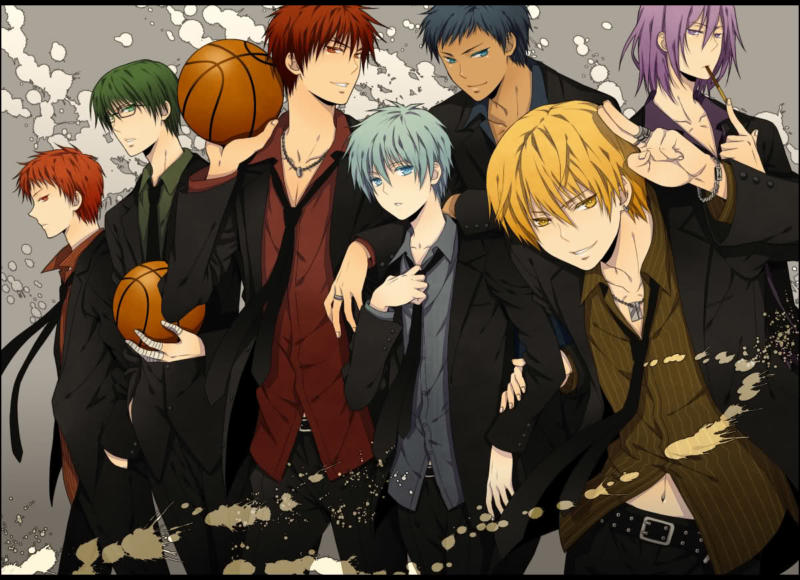
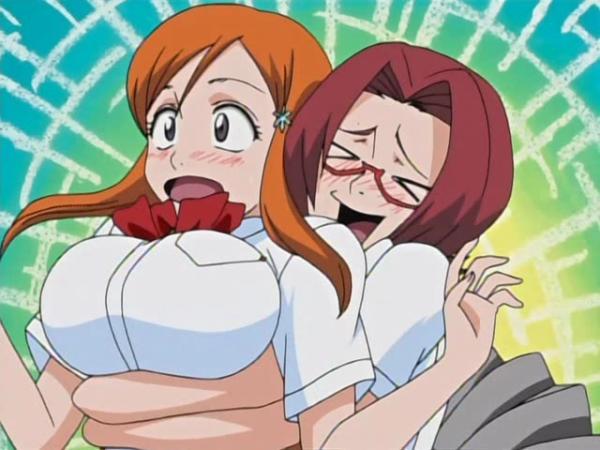
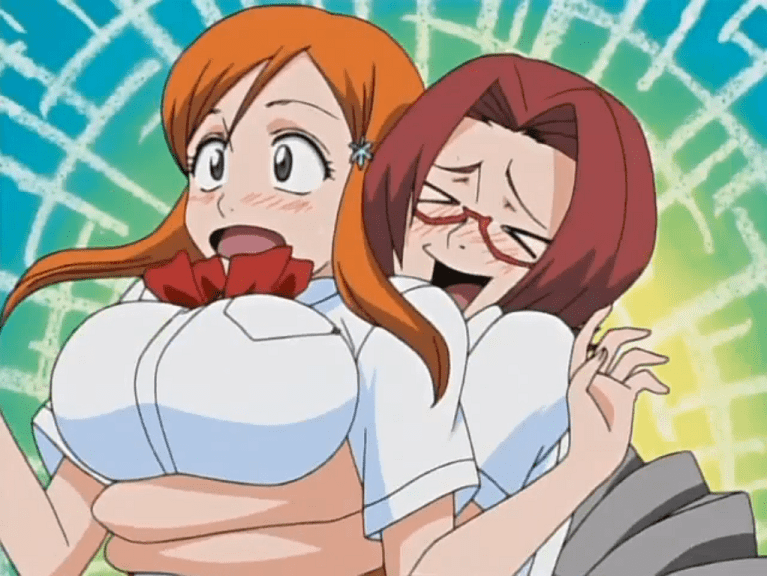
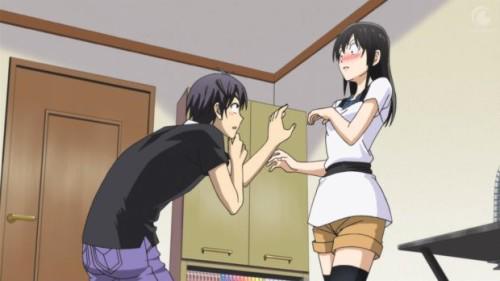
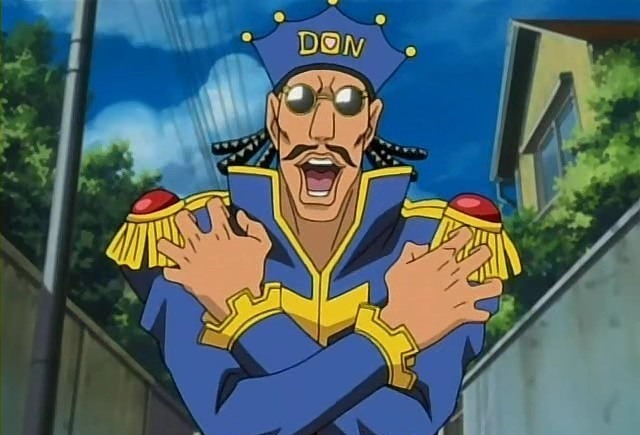

That’s a very thoughtful examination of the medium. I’d like to offer an additional, alternative viewpoint:
The culture.
Art is rooted in the interplay between one’s personality and the influential framework of their society’s values. Japanese culture prioritizes the semblance of social harmony and conformity to such a degree of indoctrination that, on an individual level, it can be unhealthily reppressive. One example of the side effects of how individual repression manifests is perverted behavior. Note the silent tolerance their society has for chikan and love hotels (or similar establishments)
Of course, both art and comedy often rely on dramatic exaggerations of commonly-observed social practices/standards. So the perverse examples in anime are both extreme enough to be entertaining, and relatable in enough to connect with the occassional unconscious thoughts and peripheral observations of many of the native audience.
Also, worldwide, Japan ranks exceptionally low in terms of gender equality.
So a fair amount of sexist objectification would amplify their tolerance for perversion of any form.
That’s a good observation! I agree that the restrictive culture is a part of the problem. It sits behind the decline in birth rates and other issues Japan has.
Just wanted to chime in that I too think Heather makes some generally good observations. However, granted that red-light areas can often be discerned by “Love Hotels”, the phenomenon mostly emerges from a general lack of privacy. When you live in a small apartment with paper-thin walls and neighbors’ windows literally 12-inches apart, even married couples may be reluctant to announce their passions. Of course, they do get used for other types of meetings, and especially with freelancers. But the more established services tend to utilize their own facilities.
Thanks, Kumi!
My friends in China have complained about how they can hear their neighbors above and below and beside them, from just walking to, well, other things. Love hotels seem to be a pragmatic solution to a real problem many in the West haven’t experienced.
I think there’s something more fundamental happening here than can be dismissed under the banner of pervy male obsession and part of this is the declining birth rate in Japan. Japan is a highly structure and largely closed society. Their economic miracle has come at a cost and this is measured in the economic challenges faced by ordinary Japanese families. Easier by far to be single and subvert desires, including sexual fantasies, into vicarious entertainment. Raising kids is tough, and kitting them out so you wipe they’re metaphorical backsides when they screwup in adult life, is a grind. I know ‘cos my 4 grown kids have all come unstuck….. Who in their right mind would welcome that when 24/7 entertainment offers so much?
There’s enough questions to ask to power a proper sociological survey on the4 impact of Manga and Anime. Will it happen? Naw: too busy watching Spy x Family. 🙂
I write SF and Fantasy, and when the mood takes me, I write Anime Flavoured Fiction.
Feedback loops can be complex. Japan’s conservative culture and easy entertainment certainly feed their negative feedback loops. How do you think Japan could break the spiral?
Living in Japan in the early 2000s, I became familiar with the “XXX” music subculture, all-female punk bands that plied the Tokyo “Live House” scene. In the mid 90s, Audrey Kimura had set up a music label, Benten Records (Named after the goddess Banzaiten), and its subsidiary, Sister Records, to promote and support these bands counter to an otherwise male-dominated environment. The reason that I mention this is that these girls weren’t promoted as either sexless or as submissive, and some of the label’s imagery pretty explicitly appealed to female sexual desire. However, there was always a subtle undercurrent that men may or may not have been party to its expression. Regardless, the bands seemed to draw mostly male audiences (sometimes including many American ex-pats), to the point where I was occasionally approached by various band members who’d noticed a familiar Japanese-looking female face in the crowds.
Comparing this aspect of a Tokyo music subculture of the time to anime, I have to wonder to what extent anime culture is a product of male fantasy and expectation, and to what degree female audiences actually fit the contextual intent… or how much they’re perhaps seeing their own interpretations? What percentage of anime writing actually emerges from female imaginations?
Do you think the attraction of men to the music subculture as opposed to women have anything to do with gender norms? Such as it’s more acceptable for men to go to see certain bands than women?
I’ve wondered about similar questions myself. Female audiences seem to be targeted particularly with newer titles like Kaguya-sama and Shikimori is Not a Cutie and even Kill la Kill. Of course, there is the shojo genre and yaoi. I should do a count on how many female manga writers there are. Do you know of a survey? Of course, many have male pennames.
Good questions. The punk scene revolves around generally high energy performances, which are perhaps just more socially interesting to more males for various reasons. The irony was that you’d likely encounter a greater proportion of the opposite sex at either type of performance (if not at the “Manhole”), though still a male majority either way. My sense was that the female bands were more “fun” oriented… songs like “Grandma’s Brassier”, and bands like “Red Bacteria Vacuum” who lived up to their Osaka origins. And they were probably more accessible to the many Americans who’d show up at some of the better known live-house locations.
I have no idea about female manga writers; however, there are many female illustrators, and it’s understood that the pressure is considered brutal. Cocoa Fujiwara was a writer and illustrator who died in 2015, supposedly due to an unspecified illness. But I think it’s generally accepted that it was a case of “karoshi”, probably self inflicted. She was 31, and there were some parallels to another artist who died by her own hand in ’98 at the same age, Chiyomi Hashiguchi, who produced “Nekojiru”.
I don’t really follow cosplay, but I’d caught that a somewhat risqué character from Kill la Kill had apparently become popular. To be honest, I think some of the cosplay (and manga by virtue) allows an acceptable venue for a little sexual expression that becomes apparent in places like Shibuya at New Year or Halloween. And the shōjo imagery even extends into music with bands like “101A”, with a free-spirited female lead and two somewhat androgynous partners. And the Japanese expression “furueru hana” (“trembling flower”) is lifted right out of yaoi.
I need to do some research on female manga writers.
I don’t believe that women watch more anime than men. Maybe women dominate the anime blogging world because they’re better at writing/blogging. “A 2020 survey conducted in the United States found that anime movies were generally more popular among men than women, with 13 percent of male respondents reporting that they found anime to be very favorable, compared to nine percent of women who said the same.”
Do you have a link for that study? I’d like to look into it. Thanks!
Sex and capital, sex sells and perversions are taken seriously, yang woman doesen’t take it as joke. They dont have fence between them selves and sexual culture, identitety has not been developed, when adult has been numbed to all kind of sexual forms. Problem is capitalism. Yangsters wannabe consumers, even they dont have job yet or education or another incomes. One way to be consumer is feed perversions and take money from it. Even they dont like it, are perverts buy themselves, perverts pay good from services. So many yang women go in world of sexuality from that point of view, and it is legal, perverts not so often has intercourse but have weird fetish. this what i remeber from my teen years, was toughie girls selling their pants, using adults underwear and dating rockn’roll guys who were much older 18, now days i see them sexual perverts. Now days photos and sugar daddies support small capitalist, who do everything for jeans or handbag, lost their senses kind of. they are not from poor families but want to have more, more and more, consumerism, addicts. sugardaddies feeding yang woman’s consuming addiction can be pleased, girl is accessory, and perversions multiply, vanity and death comes to image, Japanese are famous about extreme. Still I see this whole perverts, anime and youth as form of capitalism, some cant laugh to sexual jokes, sometimes it is not funny, it is form of business, dark part of economy.
Sorry i forgot to use CAPITAL letters 🙂 what an coincidence.
I can see what you mean about the capitalism of sexuality. I find it sad that people will trade their body and sense of self-worth for material goods. Of course, society has trained many people to not have a strong sense of self-worth. Hookup culture exemplifies this.
Hello!
I generally dislike the perverted character (or at least I dislike them when they’re being perverts). I haven’t thought much about that because the manga and anime I’ve read lately don’t meddle into sexuality or, in case of doing so, it does it with a theme in mind and it goes with it seriously. For example, I’m reading “Beastars” (there’s an anime of this on Netflix) and sexuality and growing up is explored through anthropomorphic animals.
I like the fact that you stress there are exceptions because in every culture there are troubling tropes and we shouldn’t judge an entire media because of it; however, it’s not good to ignore it either. Conversation and discussion is the key to intellectual and social progress.
Dialogue and keeping an open mind are keys to learning. Sadly, I’m not always able to do this. Confirmation bias inflicts us all.
This may be a couple of years after this was posted, but what are your thoughts on the latest trend of women accusing innocent men or boys of perverted behaviour, when the male character’s actions and thoughts lead nothing towards this, and it’s purely invented by the female character? Typically leading to the female assaulting the male violently for their own invented scenario and with no just cause while everyone around ignores, laughs or joins in?
I personally struggle to enjoy many anime these days due to this constant unjust abuse, which is already echoed in some corners of today’s society: That all men are perverts, and deserve punishment for it. Whether their actions display this or not.
It appears to be more prevalent in media with a male lead who has strong innate abilities. I see it as a form of lazy writing to invent a “weakness” to the character in an attempt to balance them out, but I fear it only perpetuates sexism and the negative reactions from men who face these assumptions in real life.
I am troubled by this trend too. The idea that men think only about sex is demeaning, and the attitude has leaked into anime. I agree: it is lazy writing. Anime’s comedy is, perhaps, the medium’s greatest weakness. It causes objectification of women and this trend of accusing men of perverted behavior (or writing men as perverts). If any mangaka are reading this: stop doing this, please.
sorry that you are incapable of thinking this through. that seems hard to bear.
these ‘women’ (female characters, not actual people) are largely created by male creators. who, like you, want to imagine that women accuse poor wittle innocent men of being perverts, how could they be so mean and sexist? and yet…what do you know…if you look at the vast majority of anime, you know damn well it’s the complete opposite – male characters written by male men who imagine those male characters being perverts. so on top of men creating such huge amounts of pedophilic anime porn as they do in the world, you and those male creators then have the audacity to act as though it’s not even true, that female characters are just making it all up, isn’t that funny? wouldn’t it be SO funny if female characters are exactly like what you’d imagine – presuming that men are being perverts, given as you want to present yourselves as being so? Why would any of those female characters assume otherwise, given the behaviour on display? whether men are making female characters bear the indignity of male perversions (most of what anime is) or are oh so wrongfully assuming it’s so.
Men present themselves as perverts, and then are offended when women are on edge? to the point where male creators even know that women will suspect it?! Are you stupid? Are you all very very stupid?
I’ve pondered the points you’ve bought up here over the years since writing this article. Why do many men portray themselves as perverts? Why do many men make “female characters bear the indignity of male perversions?” My thoughts have varied over the years as I read more research on human sexuality and learned more about media in general.
First, males are not more sexual than women. The binaries differ in their expression and consumption, but the male and female genders, according to the academic literature, are equal in their drives. The difference and more overt male expression makes men appear more sexual. Anime and manga fall into this overt male expression. Anime and manga can be tame compared to mainstream romance novels written by women for women, but novels are not quite as accessible. Some josei stories also fall into this.
There’s also market pressure and momentum. Anime, like romance novels and “New York Times Bestseller” mysteries, have certain expectations placed on them by audience expectations. People want “the same but slightly different.” As I’ve studied more medium and widened that study, I’ve noticed most genres and media need to follow conventions to succeed. Breaking those conventions is risky.
There are other reasons, like selection effect–the manga and anime that see wide release are the considered most marketable–but I’ve come to believe market pressure and momentum may the most powerful influences of these reasons.
Well, look at 80% of japanese exported culture : underaged girls with ridiculously massive breasts and revealing skirts in sailor suits. Japanese males are perverts, let it be said. It’s in their culture, and everyone seems ok with that. I think it’s pathetic, imature, demeaning to women, worrying and dangerous.
I wouldn’t generalize, but a good portion of anime does feature what you describe. Part of the blame falls on us as anime buyers. If such content didn’t sell, it wouldn’t be made.
This is why I wondered about the whole focus of this article being about why there are so many perverted men portrayed in anime. I don’t see anime that way at all. If anything, I see its image as one of over-sexualized young girls dressed up like you describe, being taken advantage of and walking and talking like tarty little whores. It’s not the male characters in anime who are the perverts. It’s the writers of this stuff and the audience it caters to.
You’re right about that portrayal of women in anime. It has a long tradition in Japanese literature too. Anime often portrays men as perverts through indirect means. The male characters often act as a stand-in for the male audience, so his glimpses and other “accidental” events are supposed to happen to the viewer. So by male characters attempting to act prudish, it increases perversity as odd as that sounds.
In general that is correct. Japans male population is overflowing with super disgusting creepy AF, COWARDLY, ball-less, beta types with more than not having a disgusting unhealthy even pedo like obsession with extremely young girls… I mean seriously most anime ecchi the girls are mostly in middle school (only around 20% of females are in HS or later) that right there says a lot. Same thing goes for hentai is still in school they are almost always in middle school. I worked over there for almost 2 months and in that time from what i experienced and saw japans male population is one of the most pathetic cowardly sad awful joke of sub-male (I cant even call them full blown males without cringing) joke of so called males. The only males I came across that seemed to have anything half remotely considered as man balls were the small handful of bosses who had been given some laughable pathetic authority over their small group to manage and they took full advantage of it trampling all over their spirit and soul grinding employees into obidience beta trash that just nodded, apologized (a ridiculous amount of that crap), and smiled as their direct boss would all but stand on their desk and crap down their throats while forcing a smile pretending to be happy about it. For me a guy that isnt a shy cowardly worthless whipped dog creeping around spying on girls cause they didnt have the balls to actually talk to them I actually had no issues at all hooking up with chicks in fact they flocked to me… and its not like im some gigachad or hot model type. I am more like around a 7 attractive wise but I aint no sad sack coward and I can talk to girls funny thing is that just the aura even got me laid cause i nailed a couple chicks over there i picked up we didnt even speak the same language yet it worked out. There were several chicks from there working with us (seriously just seeing those girls alone screamed out how sexist those losers are cause every single chick who worked there hot AF like it was the top qualification a girl had to have to get the job apparently) who spoke english… kinda and I was told how nice it was to have an actual man around who wasnt just some pathetic all talk no action pervert type who will only talk and never make a move. Another thing i learned over there was that contact trope we see in anime all the bout commoner/royal stupid crap well its actually pretty damn real over there except its more like bosses/worker biches. That country is literally dominated by a small handful of so called alpha types while everyone else is beat down from a very early age and all but brainwashed from a young to obey like a bia and work work work work while the bosses just walk around shitting on everyone while taking credit for their work. I even heard more than a couple times how bosses would find employees with attractive wives and whether by inv them over or out to drink would somehow someway end up banging their employees wives and those losers wouldnt do anything about it at all. Honestly it was one of the most depressing pathetic shitty existence for a person I have ever experienced. They are such beta weak nut trash that they have no issues or even accept getting cucked in fact its was one of the most openly popular fetishes I would hear about while it just made me disgusted… one of the workers from there was talking bout it one night out drinking and I was like wtf is wrong with yall can you even call yourself a man and instead of defending themselves they just patheticly like some whipped bitch dog bowed and apologized like wtf? From what i experienced calling the male population men is a massive over exaggeration.
Much of what you touch on with bosses and subordinates comes from Japan’s long history of hierarchical organization based on Confucian philosophy. It has little to do with “alpha” or “beta” males; rather, it’s the force of over 1,000 years of cultural momentum. Ideally, senpai would look after and do what’s best for their kohei, but in practice, the system leaves people open for exploitation as you describe and for breaking people’s wills.
Even the retired Yokuzuna Hakuho recently had to bow to the pressure of the higher ranks, despite his widespread celebrity, when be became a stable master. As you say, the system can be quite harmful. It doesn’t help Japan’s birthrate or relationship situation.
Japan became a vassal of the United States after World War II. Deep issues such as politics and philosophy that might give Japanese men independent political thinking rarely appear in post-70s anime. Then Japanese men developed into economic animals in order to follow American policy and avoid conflict. This also affects the performance of male characters in the animation. It is common for a hero to give up his normal life and focus on career performance (e.g. sports anime). The other type is a perverts .
You make a good point. The extreme focus-culture of Japanese men also existed in the Imperial period’s propaganda.
I hadn’t thought of that. It always strikes me as weird how many main characters would give their lives for some sense of responsibility towards others. But then again, they have a culture of a person dedicating their whole to the others, which is not necessarily that good if taken to the extreme of not caring about yourself.
I mean, you talked about sports anime, but on a wider scope, this can be also related to every character who decides others and society are more important than oneself. We don’t see many examples of main characters who are selfish enough to prefer their own ways.
An interesting part of the text is that often perverted anime characters are failed and scorned by women, but I know one exception, City Hunter’s Ryo Saeba. Even as a complete pervert, he eventually manages to have sex with women.
There are always exceptions. Thanks for pointing out one of them!
Let’s not forget that most of the time as well the males are shown to be ugly and undesirable perverts. While the females, hardly ever, easily something quite sexist, but hey, at least we are making progress.
Anime likes to portray both sexes in stereotypical ways. Some of it because of convenience. Manga and anime have only so much time to tell a story, and this shorthand helps the author jump to the interesting aspects of their stories. Every culture and subculture has a certain dialogue that follow. It takes time to change that dialogue.
Another great post. My first Japanese boyfriend (Yasu) was definitely a lifestyler. “Right Man,” whom I married, was a “Sporting Boy.” Confident Heterosexuals seems to be the best. I was never with a Grinder as far as I can tell…they are more traditional/conformists in my opinion and are less apt to be with a gaijin girl.
But back to the main point: Japanese have some serious sexual hangups and anime fans may fail to translate what they are viewing. Whereas I picture American teens “growing up” and getting over their sexual insecurities in their twenties, Japanese young people seem to carry their childish views on into adulthood. It’s problematic as it has major implications on societal progress (…the balanced harmony between work/life, male/female, old/young etc.) and can result in actual perversion that is youth focused and therefore beyond perversion. The fan however may not extrapolate that the sexual tensions of characters are not just “special cases” that create storylines, but societal reality in Japan. Again, there is this “idealization” of Japanese creativity that diefies the culture and people.
I love that you bring balance to the study of Japan and anime in particular.
It’s striking how many older male characters act like teens. It creates a warped impression of male sexuality. I always found anime’s love for, let’s not mince words, molesting troubling. Accident gropes and the like are not funny and violate the dignity of women. But, according to what you’ve experienced, this trope comes from a lack of sexual maturity in segments of Japanese society. The problem remains: they influence otaku culture elsewhere in the world.
You know at first I was wondering why you were even bothering to discuss this topic, but by the end I was thinking this is great, and why hasn’t anyone done this before. I am with you on the fact that the pervert characters are annoying especially the more modern ones.
I had this article in my queue for several months while I debated on and off about posting it. Sometimes we have to analyze and speak out about ideas we take for granted. I’m glad you ended up enjoying the piece.